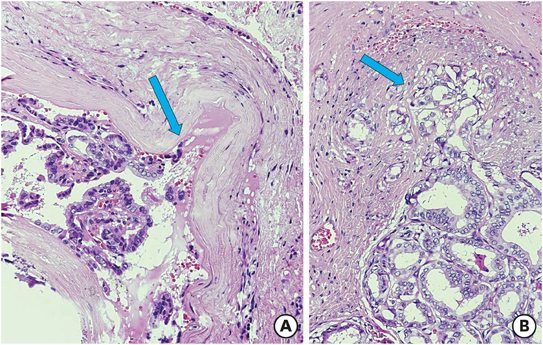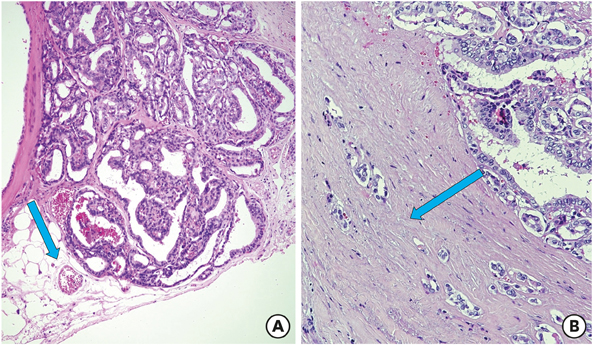J Endocr Surg.
2018 Jun;18(2):98-109. 10.16956/jes.2018.18.2.98.
Pitfalls in the 2017 TNM Classification of Thyroid Carcinoma
- Affiliations
-
- 1Division of Endocrine and Minimally Invasive Surgery, Department of Human Pathology of Adulthood and Childhood “G. Barresiâ€, University Hospital G. Martino, University of Messina, Messina, Italy. gdionigi@unime.it
- 2Division of Anatomic Pathology, Department of Human Pathology in Adult and Evolutive Age “G. Barresiâ€, University of Messina, Messina, Italy.
- 3Division of Endocrinology, Department of Human Pathology in Adult and Evolutive Age “G. Barresiâ€, University of Messina, Messina, Italy.
- 4Division of Thyroid Surgery, Jilin Provincial Key Laboratory of Surgical Translational Medicine, China Japan Union Hospital of Jilin University, Changchun, China.
- KMID: 2420765
- DOI: http://doi.org/10.16956/jes.2018.18.2.98
Abstract
- The objective of this article is to detail the 2017 tumor-node-metastasis (TNM) staging criteria for thyroid cancer. The literature presents only few contributions, with controversial results, about comparison between previous and the new TNM systems. The 2017 TNM classification categorizes either thyroid carcinomas only limited to the gland either carcinomas macroscopically infiltrating into defined anatomical structures. The "minimal extrathyroid spread" into the perithyroidal adipose tissue no longer appears as a classification parameter in the new TNM. In the present paper is discussed for the pT categories pT1a, pT1b, pT2, and pT3a. In detail, the T-categories pT1a, pT1b, pT2, and pT3a are each subdivided into true thyroid-restricted carcinomas (pT1a1, pT1b1, pT2a1, and pT3a1) and "minimal extrathyroid proliferation" carcinomas (pT1a2, pT1b2, pT2b, and pT3a2). As a basis, a strict definition of the "minimal extrathyroid propagation" of thyroid carcinomas is essential. Although the suggestion made with the additional substrate characterization makes the work of the pathologist more intricate in daily use, standardized fundamentals for demonstrating or excluding the prognostic and therapeutic relevance concerning a "minimal extrathyroid extension" in thyroid carcinoma appear to be necessary.
Keyword
Figure
Reference
-
1. Rausei S, Boni L, Rovera F, Dionigi G. Locally advanced gastric cancer: a new definition to standardise. J Clin Pathol. 2013; 66:164–165.
Article2. Rausei S, Dionigi G, Boni L. Evaluation of the Seventh American Joint Committee on Cancer/International Union Against Cancer Classification of gastric adenocarcinoma in comparison with the sixth classification. Cancer. 2011; 117:2823–2824.
Article3. Rausei S, Dionigi G, Boni L, Rovera F, Dionigi R. How does the 7th TNM edition fit in gastric cancer management? Ann Surg Oncol. 2011; 18:1219–1221.
Article4. Pellegriti G, De Vathaire F, Scollo C, Attard M, Giordano C, Arena S, et al. Papillary thyroid cancer incidence in the volcanic area of Sicily. J Natl Cancer Inst. 2009; 101:1575–1583.
Article5. Ieni A, Vita R, Magliolo E, Santarpia M, Di Bari F, Benvenga S, et al. One-third of an archivial series of papillary thyroid cancer (years 2007–2015) has coexistent chronic lymphocytic thyroiditis, which is associated with a more favorable tumor-node-metastasis staging. Front Endocrinol (Lausanne). 2017; 8:337.
Article6. Amin MB, Edge S, Greene F, Byrd DR, Brookland RK, Washington MK, et al. AJCC Cancer Staging Manual. 8th ed. New York (NY): Springer;2017.7. Sobin LH, Wittekind Ch. TNM Classification of Malignant Tumours. 6th ed. New York (NY): Wiley-Liss;2002.8. Schmid KW, Wittekind C. Die missglückte klassifikation. Pathologe. 2003; 24:338.
Article9. Sobin LH, Wittekind Ch. TNM Classification of Malignant Tumours. 5th ed. New York (NY): Wiley-Liss;1997.10. Wittekind C, Greene FL, Henson DE, Hutter RV, Sobin LH. TNM Supplement: a Commentary on Uniform Use. 3rd ed. New York (NY): Wiley-Liss;2003.11. Sobin LH, Gospodarowicz MK, Wittekind Ch. TNM Classification of Malignant Tumours. 7th ed. Hoboken (NJ): Wiley-Blackwell;2010.12. Jin BJ, Kim MK, Ji YB, Song CM, Park JH, Tae K. Characteristics and significance of minimal and maximal extrathyroidal extension in papillary thyroid carcinoma. Oral Oncol. 2015; 51:759–763.
Article13. Woo CG, Sung CO, Choi YM, Kim WG, Kim TY, Shong YK, et al. Clinicopathological significance of minimal extrathyroid extension in solitary papillary thyroid carcinomas. Ann Surg Oncol. 2015; 22:Suppl 3. S728–S733.
Article14. Shin JH, Ha TK, Park HK, Ahn MS, Kim KH, Bae KB, et al. Implication of minimal extrathyroidal extension as a prognostic factor in papillary thyroid carcinoma. Int J Surg. 2013; 11:944–947.
Article15. Hotomi M, Sugitani I, Toda K, Kawabata K, Fujimoto Y. A novel definition of extrathyroidal invasion for patients with papillary thyroid carcinoma for predicting prognosis. World J Surg. 2012; 36:1231–1240.
Article16. Moon HJ, Kim EK, Chung WY, Yoon JH, Kwak JY. Minimal extrathyroidal extension in patients with papillary thyroid microcarcinoma: is it a real prognostic factor? Ann Surg Oncol. 2011; 18:1916–1923.
Article17. Synoracki S, Wittekind C, Dralle H, Schmid KW. Definition of R1 resection in thyroid carcinoma. Chirurg. 2017; 88:740–747.18. Clain JB, Scherl S, Dos Reis L, Turk A, Wenig BM, Mehra S, et al. Extrathyroidal extension predicts extranodal extension in patients with positive lymph nodes: an important association that may affect clinical management. Thyroid. 2014; 24:951–957.
Article19. Machens A, Dralle H. Breach of the thyroid capsule and lymph node capsule in node-positive papillary and medullary thyroid cancer: different biology. Eur J Surg Oncol. 2015; 41:766–772.
Article20. Roh JL, Park JW, Jeong J, Gong G, Cho KJ, Choi SH, et al. Extranodal extension of lymph node metastasis as a prognostic indicator of recurrence and survival in papillary thyroid carcinoma. J Surg Oncol. 2017; 116:450–458.
Article21. Federative Committee on Anatomical Terminology (DE). Terminologia Anatomica: International Anatomical Terminology. Stuttgart: Thieme;1998.22. Randolph G. Surgery of the Thyroid and Parathyroid Glands. 2nd ed. Philadelphia (PA): Saunders/Elsevier;2013.23. Bliss RD, Gauger PG, Delbridge LW. Surgeon’s approach to the thyroid gland: surgical anatomy and the importance of technique. World J Surg. 2000; 24:891–897.
Article24. Dralle H. Endokrine chirurgie by Schattauer GmbH. Holderlinstrafe. 2014; 3:70174.25. Dionigi G, Kraimps JL, Schmid KW, Hermann M, Sheu-Grabellus SY, De Wailly P, et al. Minimally invasive follicular thyroid cancer (MIFTC)--a consensus report of the European Society of Endocrine Surgeons (ESES). Langenbecks Arch Surg. 2014; 399:165–184.
Article26. Schmid KW, Synoracki S, Dralle H, Wittekind C. Proposal for an extended pTNM classification of thyroid carcinoma: commentary on deficits of the 8th edition of the TNM classification (German ver-sion). Pathologe. 2018; 39:49–56.27. Tiedje V, Zwanziger D, Ting S, Schmid KW, Führer D. Molecular pathogenesis of thyroid tumors. Dtsch Med Wochenschr. 2015; 140:578–582.28. Mete O, Rotstein L, Asa SL. Controversies in thyroid pathology: thyroid capsule invasion and extrathyroidal extension. Ann Surg Oncol. 2010; 17:386–391.
Article29. Al-Qurayshi Z, Shama MA, Randolph GW, Kandil E. Minimal extrathyroidal extension does not affect survival of well-differentiated thyroid cancer. Endocr Relat Cancer. 2017; 24:221–226.
Article30. Ito Y, Tomoda C, Uruno T, Takamura Y, Miya A, Kobayashi K, et al. Prognostic significance of extrathyroid extension of papillary thyroid carcinoma: massive but not minimal extension affects the relapse-free survival. World J Surg. 2006; 30:780–786.
Article31. Radowsky JS, Howard RS, Burch HB, Stojadinovic A. Impact of degree of extrathyroidal extension of disease on papillary thyroid cancer outcome. Thyroid. 2014; 24:241–244.
Article32. Brierley JD, Gospodarowicz MK, Wittekind Ch. TNM Classification of Malignant Tumours. 8th ed. Hoboken (NJ): John Wiley & Sons;2017.33. Campennì A, Giovanella L, Siracusa M, Stipo ME, Alibrandi A, Cucinotta M, et al. Is malignant nodule topography an additional risk factor for metastatic disease in low-risk differentiated thyroid cancer? Thyroid. 2014; 24:1607–1611.
Article34. Schmid KW, Sheu-Grabellus SY. Schilddrüse. In : Amann K, Kain R, Klöppel G, editors. Pathologie: Urogenitale und Endokrine Organe, Gelenke und Skelett. Berlin: Springer;2016. p. 631–712.35. Dralle H, Musholt TJ, Schabram J, Steinmüller T, Frilling A, Simon D, et al. German Association of Endocrine Surgeons practice guideline for the surgical management of malignant thyroid tumors. Langenbecks Arch Surg. 2013; 398:347–375.
Article36. Su HK, Wenig BM, Haser GC, Rowe ME, Asa SL, Baloch Z, et al. Inter-observer variation in the pathologic identification of minimal extrathyroidal extension in papillary thyroid carcinoma. Thyroid. 2016; 26:512–517.
Article37. Park S, Oh CM, Cho H, Lee JY, Jung KW, Jun JK, et al. Association between screening and the thyroid cancer “epidemic” in South Korea: evidence from a nationwide study. BMJ. 2016; 355:i5745.
Article38. Davies L, Welch HG. Current thyroid cancer trends in the United States. JAMA Otolaryngol Head Neck Surg. 2014; 140:317–322.
Article39. Rosai J. LiVolsi VA, Sobrinho-Simoes M, Williams ED. Renaming papillary microcarcinoma of the thyroid gland: the Porto proposal. Int J Surg Pathol. 2003; 11:249–251.
Article40. Tumours of the thyroid gland. In : Lloyd RV, Osamura RY, Klöppel G, Rosai J, editors. WHO Clas-sification of Tumours of Endocrine Organs. 4th ed. Lyon: International Agency for Research on Cancer;2017. p. 65–143.41. American Thyroid Association (ATA) Guidelines Taskforce on Thyroid Nodules and Differentiated Thyroid Cancer. Revised American Thyroid Association management guidelines for patients with thyroid nodules and differentiated thyroid cancer. Thyroid. 2009; 19:1167–1214.42. Musholt TJ, Clerici T, Dralle H, Frilling A, Goretzki PE, Hermann MM, et al. German Association of Endocrine Surgeons practice guidelines for the surgical treatment of benign thyroid disease. Langenbecks Arch Surg. 2011; 396:639–649.
Article43. Goffredo P, Cheung K, Roman SA, Sosa JA. Can minimally invasive follicular thyroid cancer be approached as a benign lesion? A population-level analysis of survival among 1,200 patients. Ann Surg Oncol. 2013; 20:767–772.
Article44. Nikiforov YE, Seethala RR, Tallini G, Baloch ZW, Basolo F, Thompson LD, et al. Nomenclature revision for encapsulated follicular variant of papillary thyroid carcinoma: a paradigm shift to reduce overtreatment of indolent tumors. JAMA Oncol. 2016; 2:1023–1029.
Article
- Full Text Links
- Actions
-
Cited
- CITED
-
- Close
- Share
- Similar articles
-
- Updated guidelines on the preoperative staging of thyroid cancer
- Thyroid Cancer Staging
- Managing Thyroid Microcarcinomas
- Concurrent Medullay and Papillary Carcinoma of the Thyroid
- Erratum: Validation of the 2009 TNM Classification for Renal Cell Carcinoma: Comparison with the 2002 TNM Classification by Concordance Index




